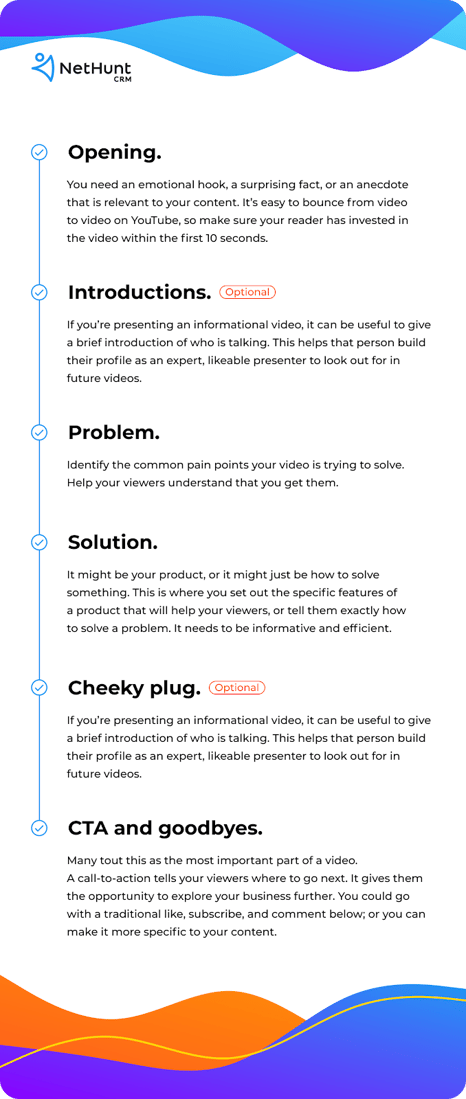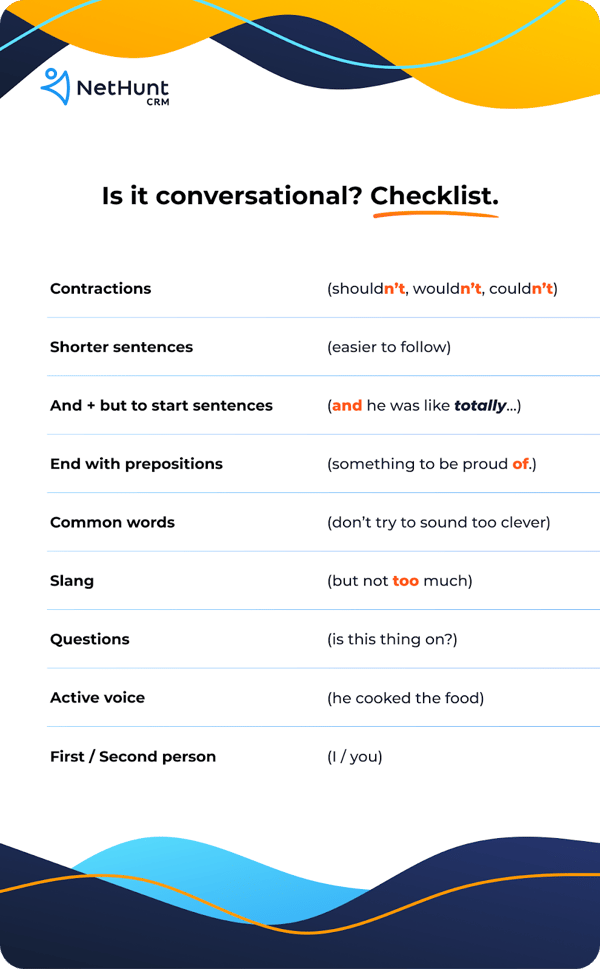

The gap between the glitzy film producer and the humble marketer isn’t as wide as you might think.
We’ve both got a story to tell, emotions to manipulate, and audiences to conquer. In both cases, it should always start with a script.
Video. The here and now of marketing your business. A powerful tool for pumping dynamite content straight into consumer eyeballs. Oberlo found that 88% of video marketers were happy with the ROI they gained from their social media video campaigns. Video works.
But not all videos work. A good video requires a team effort from writers, editors, camera operators, and presenters. A good video requires imagination, originality, and careful, detailed planning. Above everything, a good video requires a script.
A script is a structured plan of what is going to be said and done in a video. It gives you a reference point, a foundation upon which you can tame the ideas that are running around your head.
A script helps you visualize the flow of the story you are trying to tell to your audience. Most importantly, in a situation where they might not be feeling very confident, a good script gives your presenter or narrator the confidence in knowing what they are saying.
If you’re more of a copywriter than a scriptwriter, it can be easy to overlook the importance of a video script. The good thing is, the differences between a script and a blog post are not so different.
In this article, we’re going to tackle some of the differences that are unique to a video script, and break down the different steps to take towards writing a video script that will garner views, increase engagement, and improve a customer’s experience of your brand.
The more you plan your script, the more likely it is to be successful.
Your video is going to do one of three things: educate, persuade, or entertain. The purpose of your script depends on what message you want to get across and who you want to watch it. The first stage of the script-writing process is to determine the purpose of your video.
If you haven’t done it already, defining your audience is relatively straightforward. Your video needs to be aimed at a target audience, which in turn should be based on your buyer persona. Your viewers need to shape every aspect of your video; from the dialogue spoken, to the pain points addressed, and the platform it is uploaded to.
You might be tempted to try and broadly hit as many information points as you can. Don’t. Your video and script need to focus on achieving one goal for your audience. Too many points mean things get complicated and messages become diluted.
Ask yourself what the key takeaways will be, what your call-to-action is, and what pain points you are trying to settle.
An outline is a brief synopsis of a script, summing up everything will happen and be said in each part of a video. This outline is going to help you share your ideas with managers and colleagues so they can give their input more freely.
Generally, marketing video scripts are made up of the same tried-and-tested formula. Obviously, you’re free to experiment with whichever structure you deem suitable and interesting – at your own peril. Just bear in mind that the following structure is known to work.

At this point, your script can be made up of simple notes. We’ll flesh it out later on.
Your visuals are just as important as your speaker. If your video is the same person rambling on about the same thing for five minutes, it won’t knock anybody’s socks off. Visuals help break your video up and stimulate viewer minds into continuing to watch.
It can be a skit, some statistics, a slideshow, a meme; anything. Visuals should be relevant, simple, and informative rather than abstract or metaphorical. It’s important for them to complement what the speaker is saying without taking the stage away from them.
When putting meat on the bones of your script, you need to figure out the format in which it will be performed. Your script is going to be read by one of two people: a narrator or a presenter. If your video is all visuals with a narrator providing the voiceover, then your script can be written out in full.
“Personally, I find it easy to get distracted when somebody is clearly reading a script. I lose faith in them when they get those wobbly eyes darting from the camera, to the screen, and back to the camera again. Next video please.”
If you opt for a presenter standing next to your visuals, then it’s important to know how they are going to access your script. In the absence of an expensive teleprompter, write a prompt version of your script and display it on a screen behind the camera.
It might seem counterintuitive, but the fewer words, the better. If a script is written in note form, a presenter can grasp what they need to say next and fill in the blanks when you hit record. Please don’t read word-for-word. We’re trying to make your video as natural as possible.
Read your work. Then, read it again. Read it out loud to get a grasp of where emphasis needs to be placed; mark it in the text. Get rid of any typos or mistakes that could cause your narrator or presenter to trip up. Lose any fluff, waffle, and fuzz that are getting in the way of the message you are trying to convey. Read it non-stop, in front of a mirror, and time yourself to see how long it takes. It should take no longer than five minutes.
Remember, we’re going for maximum input, minimum word count. Ask yourself: is it good enough?
Is that even a word? Regardless, do it. You want your presenter or narrator to be as approachable and un-robotic as possible. Hopefully, you’re not writing propaganda for a supreme leader. Instead, you’re trying to open up a two-way conversation between your brand and your viewers. Trust is the name of the game, and you’re not going to win it with big words in big sentences and industry jargon.
It’s important to remember that we are writing for a speaker, and written and spoken language are very different. The checklist below offers guidance for more conversational writing.

You might proofread your script a thousand times and think you’ve played an absolute blinder. Still, that’s only two eyes that have seen it. It’s time to get a second opinion. And a third, forth, and fifth if you’re feeling brave.
If your video is good, it’s going to be viewed by thousands of people with thousands of different opinions. It’s a good idea to get your colleagues together and take your script for a test run to see what they think.
Use this as a brainstorming session and take notes of any other ideas that they might have. If the team agrees an idea is good, it’s never too late to stick it in your script. Besides, it might be a laugh.
Your knees are weak, your arms are heavy. It’s time for your script to go live. Standing in front of a camera for the first time, trying to make it look like you’ve done it for years is nerve-wracking. If you’re lucky, somebody else is going to read your script for you. If you’re as unlucky as I have been, you’re the writer and the presenter.
At this point, it’s practice, practice, practice. You should have a dress rehearsal and film a quick run through of your script, on camera, to see where things can be emphasised, corrected, and improved. It’s important to see how long it’s going to take in reality, and you should be aiming for 125 to 150 words per minute to be clear but concise.
For presenters, more than narrators, it’s important to know their script as intimately as possibly. This doesn’t mean memorising it word-for-word. It means they need to understand intonation, emphasis, and where particularly tricky sentences are placed so they can be ready for them. Once a throwaway has been recorded, watch it back and understand any changes that need to be made.
This is a redacted version of a script for a YouTube video on building the perfect LinkedIn profile:
|
AUDIO |
VISUAL |
|
Hook |
If you build it, they will come is a phrase from Kevin Costner’s classic 1989 film Field of Dreams. But who knew that he was actually talking about your LinkedIn profile? |
Snippet from ‘Field of Dreams; the wind whispers if you build it, they will come. |
Introductions |
Hey guys! I’m George. We’re NetHunt. And this is a complete guide on how to make the perfect sales manager’s LinkedIn profile. |
George talking into camera, waving, and smiling. |
Problem |
Lots of people know about LinkedIn’s potential as a tool for finding and nurturing leads. But a lot of people don’t know about its potential as a tool for inbound marketing. As a sales professional, you couldn’t really ask for a better platform than LinkedIn. It’s a place for prospects to come to you. |
Close up to George’s face, still talking into the camera. George points at camera as he says ‘you’. |
Solution |
If you build the perfect LinkedIn profile, they will come. Let's start with the basics. Your profile picture needs to be clear, friendly, and professionally appropriate. Your headline needs to be specific enough to stand out, but broad enough to include your wide range of skills. Your about section is extremely important to your prospects, it goes into detail about you as a person. There are some big DOs and big DON’Ts when it comes to writing about yourself… *expand* Your endorsements are recommendations from other users explaining why you are simply the best. To gather a trustworthy, comprehensive list of endorsements, you need a plan of action. *expand* |
George to camera. Slide: appropriate photo vs. inappropriate photo. Slide: appropriate headline vs. inappropriate headline. George to camera. Table showing the DOs and DON’Ts of About writing. Tina Turner - Simply the Best snippet Slide: Endorsement POA |
|
Cheeky Plug |
And, of course, use NetHunt CRM’s LinkedIn integration to help cultivate and store LinkedIn leads within your Gmail inbox. All you need to do is download the extension from Chrome webstore and you are ready to rock! |
NetHunt extension walkthrough |
|
CTA and Goodbye |
Guys, our time has, once again come to an end. Go out there and rock LinkedIn! But before you do, don’t forget to hit those like and subscribe buttons below. Let us know in the comments what topic you want us to tackle in our next video. Until next time, see you! |
Snippet from Rocky II where he is running with famous music. Slide: like, comment, and subscribe buttons George to camera. Waving and smiling. |
No matter how much you pray for it, there’s no quality content tree from which you can pluck the ripest, quality content to broadcast to the masses. Nobody said it was easy. It takes creativity, dedication, and practice, practice, practice. You might write a whole script out and it turns out to completely flop on camera.
Just blame somebody else, get it rewritten, and go again. The tears and tantrums are worth it in the end.
Now that you're an expert on video script writing, make sure to use the right video hosting platforms to get your message out there. YouTube is a given, but there are so many other avenues you should explore! Good luck!
George is a Marketing Journalist for NetHunt CRM. He likes to bring creativity and flare to typically humdrum topics. If you can’t find him writing his next article, you’ll probably find him writing his next book.
Gone are the days when you can share just one picture in an Instagram post. Now, not only can...
 by Kristen McCabe
by Kristen McCabe
It's February, and that means you're probably halfway through the implementation phase of your...
 by Kai Tomboc
by Kai Tomboc
Video is one of the best tools marketers and business owners can use to build brand awareness,...
 by Katie Duncan
by Katie Duncan
Gone are the days when you can share just one picture in an Instagram post. Now, not only can...
 by Kristen McCabe
by Kristen McCabe
It's February, and that means you're probably halfway through the implementation phase of your...
 by Kai Tomboc
by Kai Tomboc
Never miss a post.
Subscribe to keep your fingers on the tech pulse.



